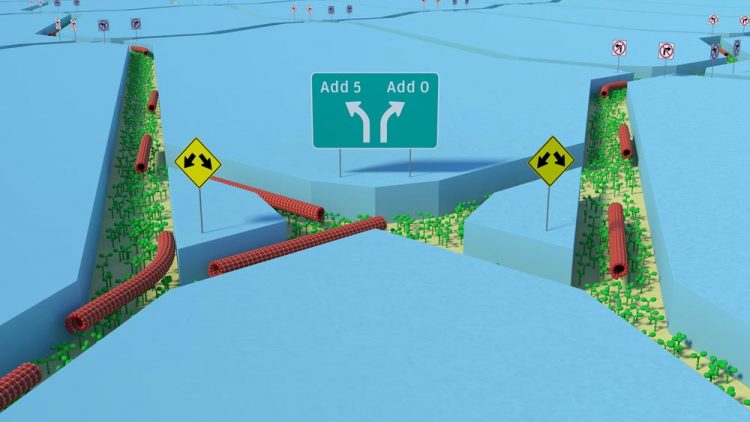World’s First Parallel Computer Based on Biomolecular Motors

Fig. 3b Split junction overview. Illustration of protein filaments (red) propelled by molecular motors (green) arriving at a junction where they perform a calculation operation (adding 5 or adding 0).
A study published this week in Proceedings of the National Academy of Sciences reports a new parallel-computing approach based on a combination of nanotechnology and biology that can solve combinatorial problems.
The approach is scalable, error-tolerant, energy-efficient, and can be implemented with existing technologies. The pioneering achievement was developed by researchers from the Technische Universität Dresden and the Max Planck Institute of Molecular Cell Biology and Genetics, Dresden in collaboration with international partners from Canada, England, Sweden, the US, and the Netherlands.
Conventional electronic computers have led to remarkable technological advances in the past decades, but their sequential nature –they process only one computational task at a time– prevents them from solving problems of combinatorial nature such as protein design and folding, and optimal network routing.
This is because the number of calculations required to solve such problems grows exponentially with the size of the problem, rendering them intractable with sequential computing. Parallel computing approaches can in principle tackle such problems, but the approaches developed so far have suffered from drawbacks that have made up-scaling and practical implementation very difficult.
The recently reported parallel-computing approach aims to address these issues by combining well established nanofabrication technology with molecular motors which are highly energy efficient and inherently work in parallel.
In this approach, which the researchers demonstrate on a benchmark combinatorial problem that is notoriously hard to solve with sequential computers, the problem to be solved is ‘encoded’ into a network of nanoscale channels (Fig. 1a).
This is done, on the one hand by mathematically designing a geometrical network that is capable of representing the problem, and on the other hand by fabricating a physical network based on this design using so-called lithography, a standard chip-manufacturing technique.
The network is then explored in parallel by many protein filaments (here actin filaments or microtubules) that are self-propelled by a molecular layer of motor proteins (here myosin or kinesin) covering the bottom of the channels (Fig. 3a). The design of the network using different types of junctions automatically guides the filaments to the correct solutions to the problem (Fig. 1b).
This is realized by different types of junctions, causing the filaments to behave in two different ways. As the filaments are rather rigid structures, turning to the left or right is only possible for certain angles of the crossing channels. By defining these options (‘split junctions’ Fig. 2a + 3b and ‘pass junctions’, Fig. 2b + 3c) the scientists achieved an ‘intelligent’ network giving the filaments the opportunity either to cross only straight or to decide between two possible channels with a 50/50 probability.
The time to solve combinatorial problems of size N using this parallel-computing approach scales approximately as N2, which is a dramatic improvement over the exponential (2N) time scales required by conventional, sequential computers. Importantly, the approach is fully scalable with existing technologies and uses orders of magnitude less energy than conventional computers, thus circumventing the heating issues that are currently limiting the performance of conventional computing.
Press Contacts:
Prof. Dr. Stefan Diez
Technische Universität Dresden
ZIK B CUBE – Center for Molecular Bioengineering
Tel.: +49 (0) 351 463 43010
Fax: +49 (0) 351 463 40322
stefan.diez@tu-dresden.de
Dr. Till Korten
Technische Universität Dresden
ZIK B CUBE – Center for Molecular Bioengineering
Tel.: +49 (0) 351 210 2662
till.korten@tu-dresden.de
Press Images
Image Credits: Till Korten, B CUBE; Mercy Lard, Lund University; Falco van Delft, Philips Research
Media Contact
All latest news from the category: Information Technology
Here you can find a summary of innovations in the fields of information and data processing and up-to-date developments on IT equipment and hardware.
This area covers topics such as IT services, IT architectures, IT management and telecommunications.
Newest articles

A ‘language’ for ML models to predict nanopore properties
A large number of 2D materials like graphene can have nanopores – small holes formed by missing atoms through which foreign substances can pass. The properties of these nanopores dictate many…

Clinically validated, wearable ultrasound patch
… for continuous blood pressure monitoring. A team of researchers at the University of California San Diego has developed a new and improved wearable ultrasound patch for continuous and noninvasive…

A new puzzle piece for string theory research
Dr. Ksenia Fedosova from the Cluster of Excellence Mathematics Münster, along with an international research team, has proven a conjecture in string theory that physicists had proposed regarding certain equations….



